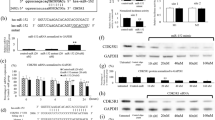Abstract
MicroRNAs serve a crucial role in the regulation of malignant biological behavior of Ewing’s sarcoma (ES). Abnormal expression of miR-107 has been reported in a cohort of cancers, while its exact function in ES remains unclear. Hence, we explored the expression of miR-107 in ES cells and detected its effects on the malignant phenotype of ES cells. Firstly, we perceived the under-expression of miR-107 in human ES cells contrast with the human mesenchymal stem cells. Over-expression of miR-107 restrained cell proliferation and tube formation, arrested cell cycle progression, and facilitated cell apoptosis in SK-ES-1 and RD-ES cell lines. Furthermore, hypoxia inducible factor-1β (HIF-1β) was assumed as a target gene of miR-107. We confirmed the target role of HIF-1β in ES cells. Finally, restoring the expression of HIF-1β could partly abolish miR-107-mediated tumor suppression in ES cells. In conclusion, our results advised that miR-107 suppressed the malignant biological ability of ES cells through targeting HIF-1β.




Similar content being viewed by others
References
Thorn D, Mamot C, Krasniqi F, Metternich F, Prestin S. Multimodality treatment in Ewing’s sarcoma family tumors of the maxilla and maxillary sinus: review of the literature. Sarcoma. 2016;2016:3872768. doi:10.1155/2016/3872768.
Rupaimoole R, Calin GA, Lopez-Berestein G, Sood AK. miRNA deregulation in cancer cells and the tumor microenvironment. Cancer Discov. 2016;6(3):235–46. doi:10.1158/2159-8290.CD-15-0893.
Slattery ML, Herrick JS, Mullany LE, Wolff E, Hoffman MD, Pellatt DF, et al. Colorectal tumor molecular phenotype and miRNA: expression profiles and prognosis. Mod Pathol. 2016;29(8):915–27. doi:10.1038/modpathol.2016.73.
Zhang Z, Li Y, Huang L, Xiao Q, Chen X, Zhong J, et al. Let-7a suppresses macrophage infiltrations and malignant phenotype of Ewing sarcoma via STAT3/NF-kappaB positive regulatory circuit. Cancer Lett. 2016;374(2):192–201. doi:10.1016/j.canlet.2016.02.027.
Zhang ZC, Liu JX, Shao ZW, Pu FF, Wang BC, Wu Q, et al. In vitro effect of microRNA-107 targeting Dkk-1 by regulation of Wnt/beta-catenin signaling pathway in osteosarcoma. Medicine. 2017;96(27):e7245. doi:10.1097/md.0000000000007245.
Xu H, Zhang Y, Pena MM, Pirisi L, Creek KE. Six1 promotes colorectal cancer growth and metastasis by stimulating angiogenesis and recruiting tumor-associated macrophages. Carcinogenesis. 2017;. doi:10.1093/carcin/bgw121.
Meng S, Cao J, Wang L, Zhou Q, Li Y, Shen C, et al. MicroRNA 107 partly inhibits endothelial progenitor cells differentiation via HIF-1beta. PLoS ONE. 2012;7(7):e40323. doi:10.1371/journal.pone.0040323.
Tarazona N, Navarro L, Cejalvo JM, Gambardella V, Perez-Fidalgo JA, Sempere A, et al. Primary paraesophageal Ewing’s sarcoma: an uncommon case report and literature review. Onco Targets Ther. 2015;8:1053–9. doi:10.2147/OTT.S80879.
Grassetti L, Torresetti M, Brancorsini D, Rubini C, Lazzeri D, Di Benedetto G. A peculiar case of large primary cutaneous Ewing’s sarcoma of the foot: case report and review of the literature. Int J Surg Case Rep. 2015;15:89–92. doi:10.1016/j.ijscr.2015.08.024.
Ren G, Yu B. Post-transcriptional control of miRNA abundance in Arabidopsis. Plant signal Behav. 2012;7(11):1443–6. doi:10.4161/psb.21956.
Sen CK, Ghatak S. miRNA control of tissue repair and regeneration. Am J Pathol. 2015;185(10):2629–40. doi:10.1016/j.ajpath.2015.04.001.
Osaki M, Okada F, Ochiya T. miRNA therapy targeting cancer stem cells: a new paradigm for cancer treatment and prevention of tumor recurrence. Therap Deliv. 2015;6(3):323–37. doi:10.4155/tde.14.122.
Nugent M. microRNA and bone cancer. Adv Exp Med Biol. 2015;889:201–30. doi:10.1007/978-3-319-23730-5_11.
Iida K, Fukushi J, Matsumoto Y, Oda Y, Takahashi Y, Fujiwara T, et al. miR-125b develops chemoresistance in Ewing sarcoma/primitive neuroectodermal tumor. Cancer Cell Int. 2013;13(1):21. doi:10.1186/1475-2867-13-21.
Cui J, Mo J, Luo M, Yu Q, Zhou S, Li T, et al. c-Myc-activated long non-coding RNA H19 downregulates miR-107 and promotes cell cycle progression of non-small cell lung cancer. Int J Clin Exp Pathol. 2015;8(10):12400–9.
Zhang Z, Zhang L, Yin ZY, Fan XL, Hu B, Wang LQ, et al. miR-107 regulates cisplatin chemosensitivity of A549 non small cell lung cancer cell line by targeting cyclin dependent kinase 8. Int J Clin Exp Pathol. 2014;7(10):7236–41.
Ayremlou N, Mozdarani H, Mowla SJ, Delavari A. Increased levels of serum and tissue miR-107 in human gastric cancer: correlation with tumor hypoxia. Cancer Biomark. 2015;15(6):851–60. doi:10.3233/CBM-150529.
Wang S, Ma G, Zhu H, Lv C, Chu H, Tong N, et al. miR-107 regulates tumor progression by targeting NF1 in gastric cancer. Sci Rep. 2016;6:36531. doi:10.1038/srep36531.
Villanueva MT. Angiogenesis: a sudden rush of blood to the tumour. Nat Rev Cancer. 2015;15(3):135. doi:10.1038/nrc3914.
van der Schaft DW, Hillen F, Pauwels P, Kirschmann DA, Castermans K, Egbrink MG, et al. Tumor cell plasticity in Ewing sarcoma, an alternative circulatory system stimulated by hypoxia. Can Res. 2005;65(24):11520–8. doi:10.1158/0008-5472.can-05-2468.
Li Y, Mao L, Gao Y, Baral S, Zhou Y, Hu B. MicroRNA-107 contributes to post-stroke angiogenesis by targeting Dicer-1. Sci Rep. 2015;5:13316. doi:10.1038/srep13316.
Deng B, Du J, Hu R, Wang AP, Wu WH, Hu CP, et al. MicroRNA-103/107 is involved in hypoxia-induced proliferation of pulmonary arterial smooth muscle cells by targeting HIF-1beta. Life Sci. 2016;147:117–24. doi:10.1016/j.lfs.2016.01.043.
Lauzier MC, Michaud MD, Dery MA, Richard DE. HIF-1 activation during tumor progression: implications and consequences. Bull Cancer. 2006;93(4):349–56.
Meijer TW, Kaanders JH, Span PN, Bussink J. Targeting hypoxia, HIF-1, and tumor glucose metabolism to improve radiotherapy efficacy. Clin Cancer Res. 2012;18(20):5585–94. doi:10.1158/1078-0432.CCR-12-0858.
Yamakuchi M, Lotterman CD, Bao C, Hruban RH, Karim B, Mendell JT, et al. P53-induced microRNA-107 inhibits HIF-1 and tumor angiogenesis. Proc Natl Acad Sci USA. 2010;107(14):6334–9. doi:10.1073/pnas.0911082107.
Acknowledgements
This project is Funded by the National Nature Science Foundation of China (Grant No. 81502329); Program of Science and Technology of ChongQing Commission (Grant No. KJ1600228); Programs of Yongchuan Hospital of ChongQing Medical University (Grant Nos. YJZQN 201514; YCZQN201511).
Author information
Authors and Affiliations
Corresponding authors
Ethics declarations
Conflict of interest
The authors declare that they have no potential conflicts of interest.
Ethical statement
All procedures performed in studies involving human participants were in accordance with the ethical standards of the Ethics Committee of Chongqing Medical University and with the 1964 Helsinki declaration and its later amendments or comparable ethical standards.
Informed consent
Informed consent was obtained from all individual participants included in the study.
Rights and permissions
About this article
Cite this article
Chen, J., Zhou, X., Xiao, Q. et al. MiR-107 suppresses cell proliferation and tube formation of Ewing sarcoma cells partly by targeting HIF-1β. Human Cell 31, 42–49 (2018). https://doi.org/10.1007/s13577-017-0183-9
Received:
Accepted:
Published:
Issue Date:
DOI: https://doi.org/10.1007/s13577-017-0183-9




